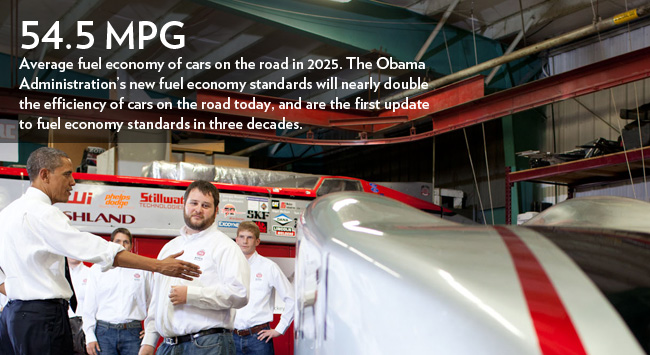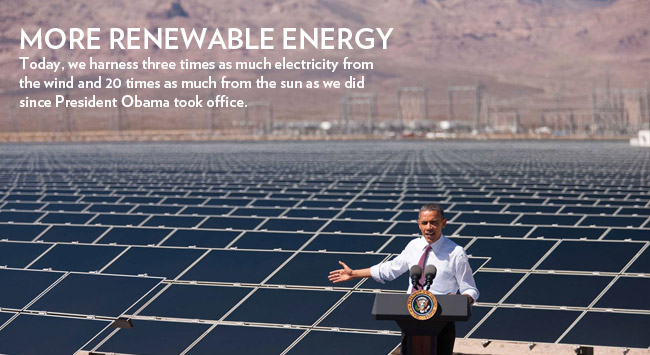Energy and Environment Latest News
White House Releases Implementation Report on National Strategy for the Arctic
Posted by on March 27, 2015 at 11:23 AM EDTToday, the Obama administration released a report highlighting progress made by the federal government in the Arctic during 2014. In recognition of the Arctic’s importance to the nation, the President released The National Strategy for the Arctic Region in May 2013. This Strategy addressed a wide range of issues in the Arctic, including: national security, transportation, renewable and non-renewable energy development, increased maritime traffic, environmental stewardship, and research. The President followed the Strategy with an Implementation Plan in January 2014, which directs federal departments and agencies to complete specific milestones for the National Strategy over the next 10 years. To maintain transparency in Arctic activities, the Administration is releasing an annual report that demonstrates progress on the goals that were laid out in the Implementation.
The Arctic has critical long-term strategic, ecological, cultural, and economic value. It is imperative that we continue to protect our national interests in the region. These interests include: national defense; sovereign rights and responsibilities; maritime safety; energy and economic benefits; environmental stewardship; promotion of science and research; and preservation of the rights, freedoms, and uses of the sea as reflected in international law.
Learn more about Energy and EnvironmentPartnering to Save our Endangered Species
Posted by on March 26, 2015 at 4:59 PM EDTEd. Note: This blog post introduces you to Michael Bean, Principal Deputy Assistant Secretary for Fish and Wildlife and Parks.
America supports more than 200,000 unique plants and animals, making us one of the top 10 countries in the world for our wildlife diversity. Our Endangered Species Act (ESA) represents one of the world’s first and best laws designed to protect species. We are proud of the constant innovation that has made us more effective at saving special species and places that matter to all Americans.
Last month, a small fish called the Oregon chub, was declared the first fish to be recovered and taken off the endangered species list. It joins 30 other plant and wildlife species successes announced since President Obama took office, including fully recovered ones and others that never needed federal protection because private and government action turned them around in time.
And now, we have the opportunity to see more of the public-private partnerships that make those recovery successes possible. The U.S. Fish and Wildlife Service announced the approval last week of the first conservation banks that will bring private investment and a market-based approach to conservation efforts in Wyoming.
Conservation banks are an innovation in endangered species policy first launched in 2002, with more than 130 banks now established. At a bank site, private investors or local government permanently protect property and restore habitat to create ‘credits’ measured by the level of endangered species benefits produced. Once benefits for species have been achieved and measured, credits are released and can be used to offset harm that may be caused by a development project happening elsewhere. Conservation banks are just one example of the flexible, win-win approaches possible under the Endangered Species Act (ESA) that help spur wildlife recovery, support farmers and ranchers, and facilitate progress on infrastructure projects.
The new conservation bank in Wyoming is part of an 11-state effort to save a bird called the greater sage grouse. The privately-funded bank will allow impacts in low quality habitat, for example from oil and gas drilling, to be offset with credits for protecting and enhancing habitat in the most important landscapes for the bird’s survival and recovery. The bank protects more than 100,000 acres of high quality habitat for this iconic Western bird now being considered for listing under ESA.
The now-recovered Oregon chub benefited from ‘safe harbor’ agreements with private landowners in Oregon’s Willamette Valley. Those landowners have allowed fish to be reintroduced to ponds and streams on their property in exchange for the promise that they will face no additional regulation as a result of their good actions. More than 40 percent of chub populations are on private lands whose owners are voluntarily participating with this or other federal and state programs.
Through tools like the ones described above, there are already more than 62 million acres of non-federal land across the country where partnerships between local government, private landowners and federal agencies allow wildlife recovery and other activities to fit together. That’s an area bigger than the State of Minnesota. We will continue to find innovative and effective ways to make wildlife conservation efforts more successful while allowing businesses and local communities to thrive.
Michael Bean is Principal Deputy Assistant Secretary for Fish and Wildlife and Parks at the U.S. Department of the Interior.
Learn more about Energy and EnvironmentKeeping Up with the Cabinet: Commonsense Rules for Safe and Responsible Energy Development
Posted by on March 20, 2015 at 2:29 PM EDTThis was originally posted of the Department of Interior's blog. You can read the original post here.

As Secretary of the Interior, I am fortunate to oversee American treasures like the Grand Canyon, the Statue of Liberty, and the Everglades. These are places owned by each and every American.
They are central to our national character, and it is an honor to support their long-term stewardship for the benefit of all.
As manager of 700 million acres of public subsurface estate and our offshore outer continental shelf resources, it is also my responsibility to oversee a significant portion of American energy production, including oil and natural gas, coal, and renewable resources. Just as much as any national park, these resources belong to each and every American. Their responsible development helps drive our economy and our way of life, and it is my duty to ensure that as they are developed, it is done in a balanced and thoughtful way for the public good.
Learn more about Energy and EnvironmentWest Wing Week: 03/20/2015 or, “See ya, Sparkle!”
Posted by on March 20, 2015 at 12:27 PM EDTThis week, the President dropped by the new home of a wounded warrior, met with some impressive Youth of the Year winners, celebrated St. Patrick's Day, hosted the Prince of Wales and Duchess of Cornwall, and discussed Middle Class Economics in Ohio. That's March 13 to March 19th or, "See Ya, Sparkle!"
Leading by Example on Climate Change: Our New Federal Sustainability Plan
Posted by on March 19, 2015 at 1:20 PM EDT
Late last year, in an historic joint announcement with China, President Obama set an ambitious goal for reducing the greenhouse gas emissions driving climate change – a clear sign that the United States’ commitment to leadership on climate change at home and abroad is stronger than ever.

In the latest effort to continue that push, this morning, President Obama signed an executive order that will help us stay on track to meet the new target pledged in China and ensure that the federal government leads by example as the United States moves boldly to reduce greenhouse gas emissions while boosting clean energy. This new sustainability plan for the next decade directs federal agencies to cut their greenhouse gas emissions by 40 percent by 2025. That means big cuts to the dangerous emissions driving climate change – and also big savings. In addition to 21 million metric tons of emission reductions – the same as taking 4.2 million cars of the road for a year — achieving this goal will save taxpayers up to $18 billion in avoided energy costs between 2008 and 2025.
Today’s action builds off of the strong progress the federal government has made over the past six years. Already, federal agencies have reduced greenhouse gas emissions by 17 percent since the President took office, and increased the share of electricity consumed from renewable sources from 3 percent to 9 percent in 2013. Agencies have also made progress on a number of other fronts, like reducing water use by 19 percent since 2007. But there is much more work to do – and that’s what today’s announcement is all about.
To achieve this level of government-wide progress, each of our agencies has had to step up and take real action. And it’s working. Here are a few examples:
Learn more about Energy and EnvironmentHow To Tackle Illegal Fishing
Posted by on March 15, 2015 at 5:40 PM EDTMore than 2.5 billion people worldwide depend on fish for food and nutrition. In the United States, seafood makes up an essential part of our economy – and our plates. In 2013, Americans consumed 4.6 billion pounds of seafood.
To meet that level of demand, we need a thriving seafood industry with healthy competition and responsible stewardship of our fisheries. That’s why the U.S. uses a smart, science-based approach to manage our domestic fisheries. This approach has made us a global leader in sustainable seafood, largely ending domestic overfishing, rebuilding dozens of depleted fish stocks, and supporting near record highs in landings and revenue.
But globally, not all fishers play by the rules. Illegal, unreported, and unregulated (IUU) fishing undercuts fair competition and leads to global losses between $10 and $23 billion each year. These pirate fishers often violate even the most basic safety requirements, such as using navigation lights at night, putting law-abiding mariners at risk. And their ships serve as conduits for other dangerous criminal activities, including human trafficking. Black-market fishing seafood fraud allows black market fish to enter U.S. commerce, deceiving American consumers about the quality, quantity, origin, and sustainability of the food they eat.
These issues pose a serious threat to public health and to the health of our oceans and our economy - and the Obama Administration has a plan to address it.
Learn more about Energy and Environment
- &lsaquo previous
- …
- 10
- 11
- 12
- 13
- 14
- 15
- 16
- 17
- 18
- …
- next &rsaquo
White House Blogs
- The White House Blog
- Middle Class Task Force
- Council of Economic Advisers
- Council on Environmental Quality
- Council on Women and Girls
- Office of Intergovernmental Affairs
- Office of Management and Budget
- Office of Public Engagement
- Office of Science & Tech Policy
- Office of Urban Affairs
- Open Government
- Faith and Neighborhood Partnerships
- Social Innovation and Civic Participation
- US Trade Representative
- Office National Drug Control Policy








